4-Day Weekend in Tasmania: Wine Sipping, Park Hopping, and Golf on the Edge of the World
Visitors to Australia generally have a shortlist of icons they want to tick off: Sydney’s Harbour Bridge and Opera House, the Melbourne Cricket Ground, Uluru (Ayers Rock) at sunset, the novelty of skiing in July, holding a koala bear, etc. But there’s far more to heading Down Under than iconic city scenes, massive monoliths, “off-season” schussing, and curious wildlife.
Enter Tasmania. This little-known island state south of the mainland is an underrated wilderness adventure playground and gastronomic gem that begs to be explored. Across the Tasman Sea, 19 national parks stand alongside award-winning vineyards producing 185 different wine labels—most of which are only available to sip locally.
Related: French Riviera Travel Guide: How to Spend a 4-Day Weekend
The best part is this pocket rocket is doable in a four-day weekend, which you can tack onto a broader Australia-wide trip. One warning, though: Once you’ve had a taste of the place known as the “Apple Isle” for its abundance of fresh produce, you’ll want to return for longer. Here’s how to see the best of Tassie on your next trip and what to know before you go.
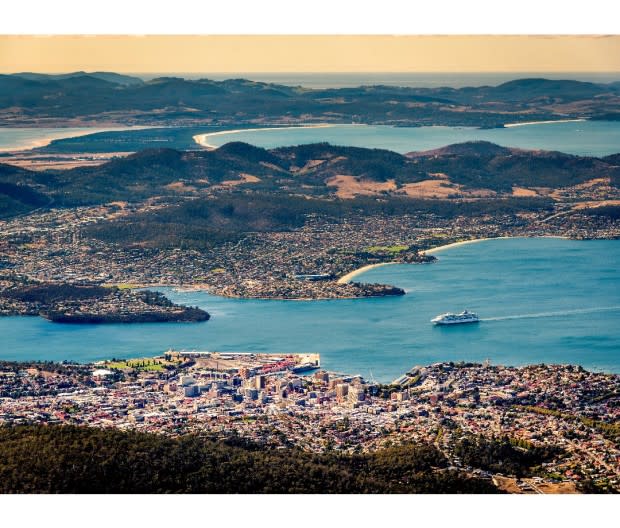
Posnov/Getty Images
Where Is Tasmania?
Tasmania is the little tear-drop shaped island floating on its own at the bottom of Australia. It’s about the size of West Virginia with a third of the population. Its capital, Hobart, is one of the closest cities to Antarctica. Its quaint harbor historically developed as a launch point for expeditions by South Pole explorers.
Best Time to Visit Tasmania
Being so “close” to Antarctica (about 1,300 nautical miles) means Tasmania’s climate is cold compared to the rest of Australia. Summer (December–February) days warm up into 70s and 80s with winters mostly in the brisk 40s and 50s. Part of Tasmania’s appeal is the dense wilderness and cold, clean winter air. Hobart even celebrates the long nights with a massive midwinter festival called Dark Mofo, featuring large-scale public art, food, music, performing arts, and the famous Nude Solstice Swim.
How to Get to Tasmania
Australia’s east coast is a 16-hour flight across the Pacific from U.S. departure airports Los Angeles or San Francisco. It’s a slog, but once you make it to Sydney or Melbourne, flights to the Tasmanian capital of Hobart are cheap (think $250 return) and relatively quick. In fact, travel in Australia is generally inexpensive enough to justify a side trip to Tasmania, thanks to a favorable exchange rate for holders of U.S. greenbacks.
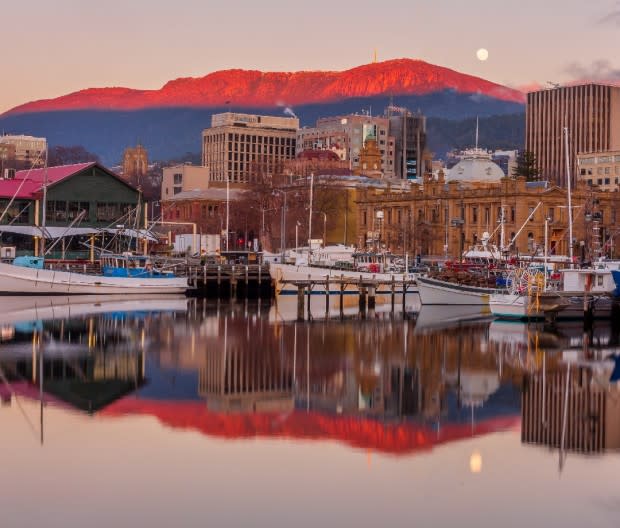
Steve Daggar Photography
Day 1—Hobart: Explore the Tasmanian Capital
Allow the dapper-uniformed staff from The Tasman hotel to collect you from Hobart airport. Their hotel is Australia’s first in the global, five-star Marriott Luxury Collection—a major coup for the island state when it opened late in the pandemic. The hotel’s recent multi-million-dollar refurbishment takes guests through three eras of Australian design, beginning with the magnificent heritage wing, bricked in sandstone originating from convict days of the 1840s. Today it’s anything but prison-like, with redwood bathtubs lording over marble bathrooms with Dyson hair dryers, Nespresso machines, automated blackout blinds, and LCD TV screens adorning the high-ceilinged walls.
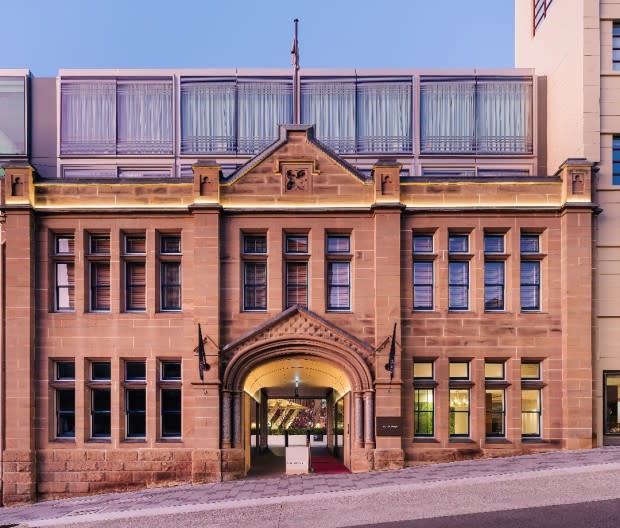
Courtesy image
Drop your bags and stroll outside to Hobart’s bustling Salamanca waterfront precinct for a pick-me-up at Parklane Espresso. Australia is a nation of caffeine aficionados, and ordering a “coffee” is not specific enough. A “long black” (with or without milk–you’ll need to advise) is the closest thing to plain coffee, if you’re not ordering the velvety, Australian-born flat white.
Hop on a ferry upriver to Hobart’s Museum of Old and New Art, known affectionately as MONA. The ferry drops you at the base of 99 stairs—a gasping way to begin what becomes a breathtaking contemporary art tour. Regather your senses with a tasting at Moorilla, MONA’s on-site winery and one of Tasmania’s oldest vineyards. Or for beer lovers, try a Moo Brew by the same company.
Related: Look Inside The World's Newest National Park That Just Opened in Australia
Speaking of beer, back downriver at the foot of Mt. Wellington stands Australia’s oldest continuously operating brewery—Cascade Brewery. Cascade’s pale ale is technically a lager and indisputably the most refreshing way to finish the iconic two-hour hike to the iconic peak overlooking Hobart.
Cocktail bar Mary Mary is named after the 19th-century hospital building it slinks inside (St. Mary’s Hospital), and still allegedly cures all kinds of ailments. The “Corpse Reviver” cocktail (gin, Lillet, dry cura?ao, lemon) is just what the doctor ordered after a big first day.
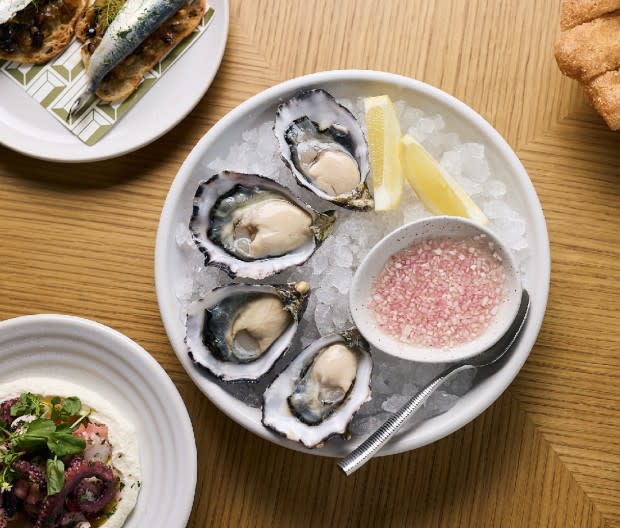
Courtesy image
Getting hungry? Renowned Australian Chef Massimo Mele, a star of MasterChef Australia, runs Peppina right next door. It’s an homage to his Italian heritage that also celebrates the produce of his hometown of Hobart with an ever-changing seasonal menu anchored in local seafood favorites: scallops and oysters.
Down the street, Institut Polaire celebrates Tasmania’s proximity to the South Pole with Antarctica-themed frosting on everything from the décor to the cocktails. Crab pasta, scallops in black garlic, and melt-in-your-mouth Australian Cape Grim beef feature on a stunning eight-course set menu that will set you back just under $80. The restaurant also acts as the tasting room for its own Tasmanian wine, Domaine Simha, and gin label, Süd Polaire.
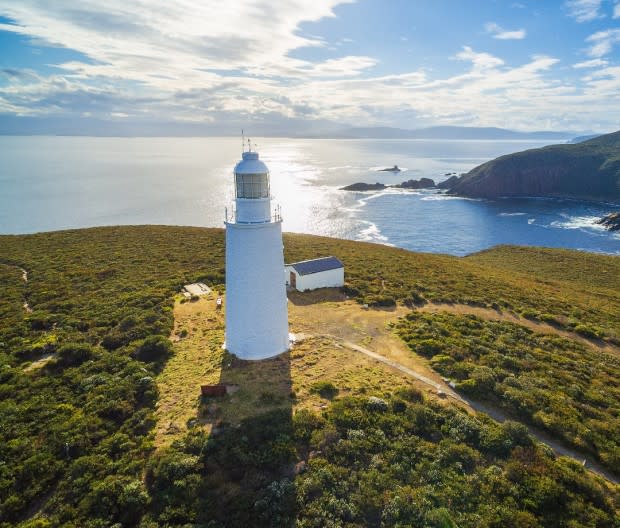
Tsvi Brav/Getty Images
Day 2—Bruny Island: Break Bread, Sip Wine, and Watch for Wombats
Rent a car from the city and drive south, through the rolling green countryside, about 30 minutes to the quaint village of Kettering. (Note: Australians drive on the left side of the road and accept U.S. drivers’ licenses for car rentals). From here, the Bruny Island Ferry will whisk you and your vehicle to a stunning parcel of wilderness where the world’s oldest living culture of Indigenous Australians settled 40,000 years ago. There’s still very little in the way of modern development here, which today’s Bruny Island population of around 600 folks see as a badge of honor.
Related: 4-Day Weekend in Quito: Volcano Hikes and Equatorial Experiments
While keeping your eyes peeled for rare Tasmanian devils, wallabies (like small Kangaroos), wombats, echidnas, and fairy penguins (near the coast), make your first pit stop at the Bruny Island Cheese Co. Pick up some grazing nibbles to complete a picnic, adding bread from the local “bakery”—which is simply an old Kelvinator fridge standing at the entry to Sheepwash Bay Road. It’s stocked daily with loaves of hot baked sourdough by the Bruny Baker, who asks you to just leave some cash in the tin for his dough.
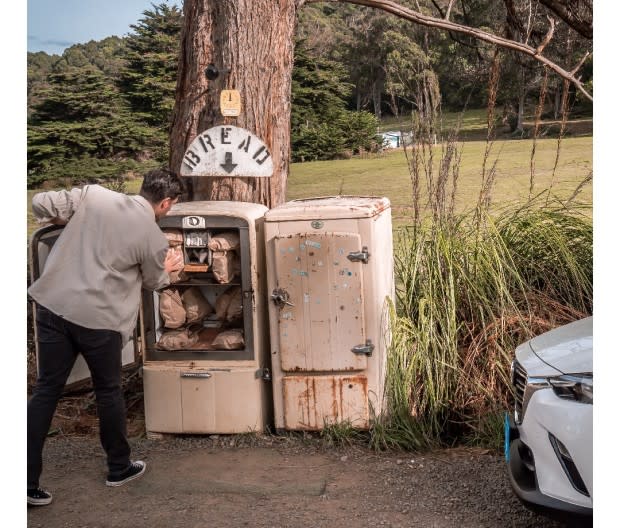
Courtesy image
Hiking (Aussie term: bushwalking) gets you to the best scenic lookouts. Check the National Parks website for trail options or download the AllTrails app for useful local tips and reviews. Cool down afterwards with a dip at the pristine beach of Two Tree Point, where British explorer Captain James Cook made landfall in 1777. You’ll need to practice your Wim Hof breathing, as the icy water temps are locked in the 50s and low 60s year-round.
Back on the Tasmanian mainland, drop into the impressive cellar door of Mewstone Wines. Sibling owners Jonathon and Matthew Hughes produce crowd-pleasing wines to suit sunny days overlooking their leafy green, England-like countryside by the water. Begin your evening drive to iconic Freycinet National Park (about 3.5 hours). Along the way, pop in to see what all the deserved fuss is about at Pooley Winery, just north of Hobart. It won Winery of the Year by Halliday Wine Companion in 2023, and the sun-drenched vineyard with its outdoor beanbags and tables offers a perfect afternoon pitstop.
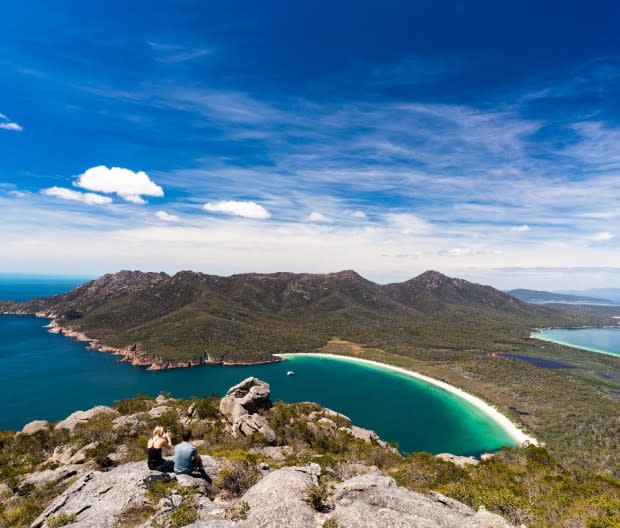
Nigel Killeen
Day 3—Freycinet National Park: Camp, Paddle, and Luxuriate at the Lodge
Freycinet National Park is a favorite spot for campers, with sites costing under $10 per night literally steps away from the glittering aqua hues, white sand, and pink granite headlands of Honeymoon Bay. You’ll sleep alongside echidnas, pademelons, and wombats. It’s so popular during Australian summer holidays (December–late January) that ballots are drawn for sites in early August.
At the other end of the accommodation scale, indulge in the ultimate luxury experience at the five-star, multi-award-winning, all-inclusive Saffire Freycinet Lodge for $1,600 per night.
The luxe pavilions of Freycinet Lodge are more moderately priced and the only accommodations situated inside the national park. The highlight here is free daily restocked minibars (you read that right) brimming with Tasmanian wine, beer, snacks, and soft drinks.
Take a morning paddle across the Mediterranean hues of Honeymoon Bay on a kayak tour with Freycinet Adventures. Lunch of fresh-caught fish and chips from Scalefish in Coles Bay should provide enough fuel to take on the 1,200-step climb up to Wineglass Bay lookout. The view is stunning, but the name is an ugly nod to Tasmania’s former whaling history—when the creatures were harpooned and dragged into the balloon-shaped bay, their blood turning the water red like Pinot.
Related: The Best New Golf Courses to Play in 2023
After the hike, hop back in your car and head north towards the iconic Barnbougle Dunes Golf Links (three-hour drive). If you have time, stop off at the Floating Sauna Lake Derby for the ultimate contrast therapy—dipping between dry heat and frigid ice swims in the peaceful lakeside wilderness. End day three with a dinner of fresh scallops and buttery steaks matched with local wines at Lost Farm Restaurant, overlooking the wild northern coast and its show-stopping sunsets.
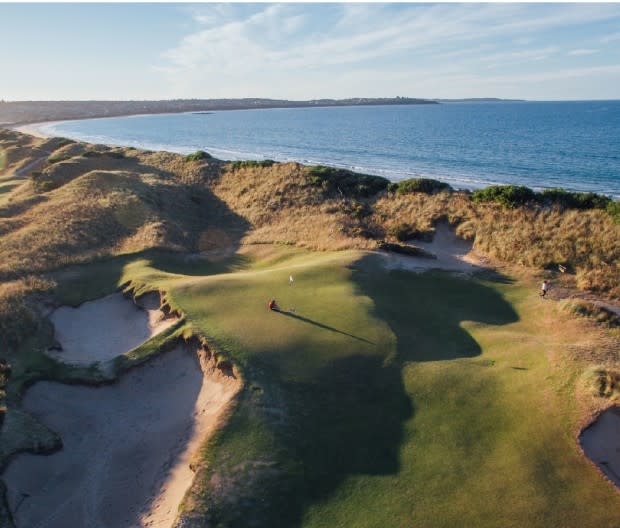
Caddie Magazine
Day 4—Hike 'n Golf: Summit Cradle Mountain and Swing at Barnbougle Dunes
A regular on world’s greatest golf course lists, the Dunes at Barnbougle was recently tapped #11 by US Golf Digest and #2 by Australian Golf Magazine—but you be the judge. We think it would be remiss to visit the island without teeing off at one of the most manicured courses south of the equator. The 14-hole Bougle Run is a great option if you’re pressed for time and want to spend it hitting irons on par 3s and 4s.
If you’re truly limited to four days flat, you’ll need to fly out from Launceston this afternoon. Fortunately, the airport is just an hour from Barnbougle, and it takes very little time getting through security.
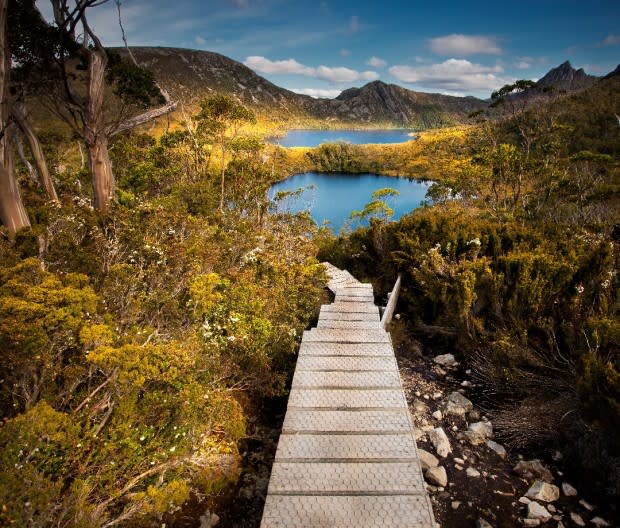
Paparwin Tanupatarachai
If you have some leeway (or prefer to skip the golf), tick off an iconic Australian hike at Cradle Mountain, about three hours’ drive west of Barnbougle. It’s part of the famous six-day Overland Track, commonly known as Australia’s premier alpine hike, immersed in thick national park bushland. The 7.5-mile return trek to the jaw-dropping peak is supposed to take about six hours due to steep climbs and ladder sections. Pressed for time, we opted to trail run it in three.
A steaming pie and a Moo Brew in front of the fire at Tavern Bar and Bistro is the perfect way to reward your efforts. You won’t have time to get back to the airport today, so book a flight for the morning and stay overnight at Cradle Mountain Lodge. Wake up early to try your hand on the property’s fly fishing lake, with one last cast—before vowing to return.